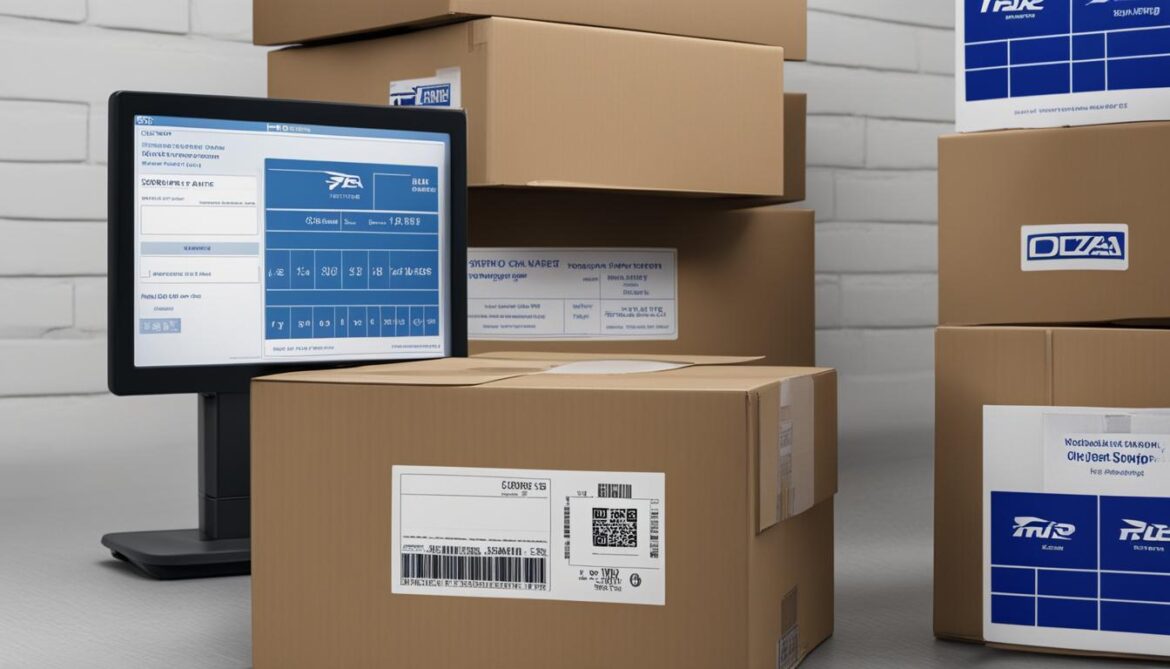As businesses continually seek to optimize expenses, budget-friendly shipping proves to be a crucial element in maintaining profitability and customer satisfaction. In today’s competitive market, finding the cheapest way to ship a package can be a game-changer for businesses of all sizes. This not only directly affects the bottom line but also plays a vital role in how customers perceive a brand. Ensuring that products are delivered inexpensively without sacrificing quality or timeliness requires a strategic approach that balances cost with performance. This introduction serves as a guiding light toward understanding the nuances of cost-effective shipping solutions, helping businesses to thrive in an economically challenged landscape.
Key Takeaways
- Identifying cost-effective shipping methods is essential for reducing overhead and increasing customer retention.
- Budget-friendly shipping options can be found by comparing rates, services, and delivery times from various carriers.
- The cheapest way to ship a package often involves a mix of strategic carrier selection, packaging, and delivery options.
- Understanding the impact of package weight, dimensions, and destination on shipping costs is key to finding affordable solutions.
- Consumer behavior is influenced by shipping costs, making affordable options a competitive advantage for businesses.
Understanding the Impact of Shipping Costs on Consumer Behavior
Exploring the relationship between shipping costs and consumer behavior unveils a dynamic that is fundamental to the success of online retail. It is often shipping costs that determine whether a virtual shopping cart makes it through checkout or gets abandoned.
The rise of e-commerce has conditioned consumers to anticipate competitive, if not free, shipping options. High shipping rates can significantly deter customers, who may otherwise be inclined to complete a purchase. To understand this, it is essential to recognize a few crucial aspects:
- Instant Gratification: Consumers tend to perceive the added cost of shipping as diminishing the instant gratification of their purchase, which can lead to a negative shopping experience.
- Comparison Shopping: With the ease of comparing online prices, consumers are more likely to abandon carts when shipping costs are introduced late in the checkout process and they believe a better deal is available elsewhere.
- Transparency: Shoppers appreciate clear, upfront information about shipping costs. Unexpected charges tacked on before payment can elicit feelings of deception, prompting cart abandonment.
Affordable shipping options act as a powerful incentive for consumers to follow through with their online purchases. Attracting and retaining customers hinges on aligning shipping strategies with consumer expectations and shopping habits.
“Competitive shipping options are no longer a luxury but a necessity for online retailers aiming to convert browsing into sales.”
Omnichannel presence amplifies the effect of shipping costs on consumer behavior. Consumers expect a seamless integration of physical and digital shopping experiences, including the shipping costs involved in both. Retailers adapting their shipping policies to fit this consumer behavior paradigm are witnessing a substantial boost in customer loyalty and repeat business.
| Consumer Expectation | Shipping Policy Adaptation Examples | Impact on Consumer Behavior |
|---|---|---|
| Free or Low-Cost Shipping | Offering tiered shipping options based on customer loyalty or order value | Increased average order value and repeat purchases |
| Transparent Pricing | Including a shipping cost calculator on product pages | Reduced cart abandonment rates |
| Fast Delivery | Implementing regional fulfillment centers | Higher customer satisfaction and positive reviews |
Ultimately, a nuanced approach to shipping policies, cognizant of consumer behavior, is indispensable. The evidence is clear that flexible and cost-effective shipping remains a decisive factor for online shopping decisions. Businesses that prioritize these aspects in their logistics strategies stand to gain a competitive edge in the ever-evolving e-commerce landscape.
Strategies for Small Businesses to Reduce Shipping Expenses
For small businesses, maintaining profitability often hinges on the ability to control overhead costs. Among the most significant are shipping expenses, which can erode margins if not managed carefully. To combat this, small businesses must adopt strategic approaches, exploring various carrier options and refining packaging techniques to curtail costs without compromising on the quality of delivery services.
Evaluating Carrier Options for Best Rates
When it comes to selecting a shipping carrier, small businesses need to assess a variety of factors to secure the best rates. These factors include shipment volume, frequency, dimensions, and weight, as well as the destination of the packages. Comparing the service levels and pricing structures of carriers like USPS, FedEx, and UPS can yield substantial savings. Small businesses should also remain vigilant for discount opportunities and consider negotiating rates with carriers or joining shipping associations to enjoy bulk discounts.
Implementing Effective Packaging Techniques
Optimizing packaging techniques is another avenue through which small businesses can minimize shipping expenses. Customizing package dimensions to fit the product snugly reduces the use of unnecessary materials and lowers the package’s weight, leading to cheaper shipping options. Using durable, lighter packaging materials can also diminish the overall freight classification, further economizing on shipping costs. Small businesses should strive to stay updated about the latest advancements in packaging solutions and sustainability practices to ensure cost efficiency and environmental responsibility.
Comparative Analysis of Shipping Rates by Carrier
With the ever-increasing demand for e-commerce and a myriad of shipping options, understanding how to strategically navigate shipping rates and making a comprehensive carrier comparison is crucial for businesses and consumers alike. This comparative analysis aims to dissect the varied costs associated with different shipping services to help make informed decisions. Careful scrutiny of rates based on package size, weight, delivery speed, and destination can lead to substantial cost savings.
To provide a concrete perspective on the complex world of shipping, let’s consider the variety of factors that carriers use to determine their rates:
- Dimensional weight versus actual weight calculations
- Distance and zone-based pricing structures
- Speed of delivery ranging from standard to express options
- Special handling or insurance requirements for fragile items
- Domestic versus international shipping rates
Contrasting these components across major carriers helps in making an accurate carrier comparison, guiding customers to find the most economically viable shipping rates with no compromise on service quality.
| Carrier | Domestic – Standard (1kg Package) | International – Economy (1kg Package) | Domestic – Express (1kg Package) |
|---|---|---|---|
| USPS | $5.50 | $25.00 | $22.50 |
| UPS | $7.00 | $28.50 | $25.50 |
| FedEx | $7.25 | $30.00 | $26.00 |
| DHL | N/A | $31.50 | N/A |
It’s evident from the table that each carrier has its unique pricing strategy, with some offering more competitive domestic rates while others may be the go-to choice for international shipping rates. Fast delivery comes at a premium, demonstrating the need for balance between speed and shipping rates. The data thus assists shippers in making a detailed carrier comparison.
Ultimately, whether you are shipping a small craft item to the next state or a bulk order across the globe, this carrier comparison will serve as a road map to navigate through the myriad of shipping rates. It underscores the importance of careful planning and understanding of the available services to optimize your shipping strategy and budget.
Identifying the Cheapest Way to Ship a Small Package
Finding the cheapest way to ship a small package can often feel like navigating a maze of complex rates and hidden fees. It’s crucial for businesses and individuals alike to identify shipping methods that minimize costs while ensuring timely delivery. This section will shed light on various service options and pricing strategies to help you pinpoint the most affordable shipping solutions.
Comparing carrier rates is a primary step towards cost-effective small package shipping. Popular carriers like USPS, UPS, and FedEx offer competitive rates for packages of smaller sizes and weights but pricing varies based on destination, speed of delivery, and additional services like tracking and insurance.
- USPS is often the go-to choice for lightweight packages, offering services such as First-Class Mail for packages under 13 ounces.
- FedEx and UPS typically cater to those in need of faster delivery, though their rates might be higher compared to USPS for similar services.
- Considering USPS Flat Rate boxes can be beneficial if your items fit into the standardized sizes offered.
Take into account the following for a clearer picture:
| Carrier | Service | Estimated Cost | Delivery Estimate |
|---|---|---|---|
| USPS | First-Class Package | $3.80 and up | 1-3 business days |
| UPS | UPS Ground | $7.57 and up | 1-5 business days |
| FedEx | FedEx Ground | $7.85 and up | 1-5 business days |
“Maximizing the value of every cent spent on shipping can be the difference between profit and loss for many businesses. It’s essential to weigh all the variables thoroughly.”
Additionally, integrate shipping software and online tools to compare real-time rates or explore discounts offered by third-party logistics providers. Many offer the cheapest way to ship a small package through bulk rate negotiations with carriers.
Ultimately, knowing the exact dimensions and weight of your package, understanding the value of time versus cost, and keeping an eye out for promotional rates can lead to significant savings when shipping small packages.
Cost-Effective Solutions for Shipping Large Packages
When it comes to shipping large packages, finding cost-effective solutions is essential for businesses looking to maintain profitability while also meeting customer expectations. The challenge of moving heavy items without incurring exorbitant costs requires a strategic approach to carrier selection and the utilization of specialized freight services.
Selecting the Right Carrier for Heavy Items
Identifying a carrier that offers reliable service for heavy items at competitive rates is a key component of handling large shipments. It’s crucial to consider factors such as the carrier’s weight limits, additional handling fees, and track record of managing bulky items safely and efficiently. Below, we compare some of the major carriers and their provisions for handling large and heavy packages.
| Carrier | Max Weight Limit | Cost-Effective for Heavy Items? | Special Services |
|---|---|---|---|
| UPS | 150 lbs | Yes, with UPS Ground with Freight Pricing | Floor loading/unloading, liftgate service |
| FedEx | 150 lbs | Yes, via FedEx Freight | Freight box option, simplified pricing |
| DHL | Varies by service | Yes, for international heavy freight | Customs clearance, global network |
| USPS | 70 lbs | Limited, best for lighter large packages | Retail Ground for non-urgent deliveries |
Utilizing Freight Services for Oversized Shipments
For oversized or particularly heavy items that exceed conventional carrier limits, freight services are the appropriate choice. Employing freight options can be substantially more cost-effective, especially for cross-country or international shipping. These services often include palletization, bulk space utilization, and comprehensive tracking systems to ensure the security and integrity of your shipments.
- Less-Than-Truckload (LTL): Suitable for shipments larger than parcel but not enough to fill an entire truck. LTL is a way to share space and cost with other shipments.
- Full Truckload (FTL): When the shipment is large enough to fill or almost fill a truck, FTL becomes the most efficient, direct, and oftentimes economical method.
- Intermodal: This involves transporting packages using multiple modes of transportation, like trucks and trains, which can lead to significant savings for long-distance shipping.
When incorporating cost-effective solutions for shipping large packages, businesses should thoroughly research and compare carrier for heavy items and the freight services they offer. Selecting the appropriate service will depend on several factors, including the size and weight of the package, the distance it needs to travel, and the level of speed required for delivery.
Exploring Budget-Friendly International Shipping Options
When expanding your business reach across borders, it’s vital to consider budget-friendly international shipping solutions. These options not only make your products accessible to a global audience but also ensure that your shipping expenses don’t outweigh your profit margins. This includes understanding the full scope of costs involved in international logistics, such as calculating duties and taxes for global deliveries and seeking out preferred carrier discounts to reduce your overall spending.
Calculating Duties and Taxes for Global Deliveries
Navigating the complex world of international tariffs and taxes can be daunting. A clear understanding of these extra costs is crucial for setting the right price point and providing customers with transparent pricing. Taxes and duties vary by country and product, and miscalculating fees can lead to unexpected expenses that harm your budget-friendly shipping strategy.
- Investigate destination country’s import regulations
- Use available customs duty calculators for preliminary estimates
- Research to see if trade agreements could offer reduced rates
Employing the right tools and seeking professional advice can significantly aid in calculating duties and taxes accurately, ensuring that your budget remains on track.
Maximizing Savings with Preferred Carrier Discounts
The choice of carrier is another crucial aspect of managing shipping expenditures. Many shipping companies offer preferred carrier discounts that can make a substantial difference. Securing these discounts may involve negotiating rates based on your shipping volume or establishing a long-term partnership with the carrier.
- Compare discount offerings from various international carriers
- Explore loyalty programs or volume-based discounts
- Consider multi-carrier shipping software for best rates
Keeping an eye on these opportunities for savings and actively engaging with carriers can result in mutually beneficial arrangements, leading to reduced shipping costs for your international deliveries. Ultimately, understanding and utilizing budget-friendly international shipping options can be pivotal in successfully managing your business’s logistics and expanding your global footprint.
Choosing the Cheapest Way to Ship a Package Based on Delivery Speed
When it comes down to logistics, balancing the cheapest way to ship a package with the delivery speed required by the recipient becomes a pivotal aspect of customer satisfaction. Cost-conscientious shipping doesn’t have to mean slow delivery. Various courier services have honed their offerings to cater to a spectrum of budgetary and time constraints. In this section, we will delve into how you can select the most cost-effective shipping option without compromising the necessity for expedience.
To align with the diverse needs of shippers, we’ve laid out a comparison of carrier services with a focus on both cost efficiency and delivery speed. We emphasize examples that highlight the cheapest way to ship a package while still meeting delivery window expectations. This comparison is crucial for individuals and businesses who aim to streamline their shipping processes and ensure they can deliver their goods both promptly and economically.
| Service Level | Estimated Delivery Speed | Cost Range |
|---|---|---|
| Economy Ground | 2-8 Business Days | $ |
| Standard Ground | 1-5 Business Days | $$ |
| Expedited | 2-3 Business Days | $$$ |
| Overnight | 1 Business Day | $$$$ |
Understanding that time is often of the essence, it’s important to assess the shipment’s urgency against the available budget. When rapid delivery isn’t paramount, economy services offer tremendous value, while expedited services become preferable for those critical last-minute shipments.
- Investigate carrier discounts that may reduce costs on quicker shipping options.
- Consider regional carriers for destinations within their standard coverage, which often offer faster delivery times at competitive rates comparable to national carriers.
- Factor in potential savings from membership-based shipping programs or business accounts, which can offer tiered pricing based on volume.
Being strategic about packaging size and weight can also significantly influence the costs associated with various delivery speeds. Small modifications in packaging can tip the scales from one cost bracket to another. Leveraging this knowledge ensures you attain the cheapest way to ship a package while expanding your boundary for desired delivery cadence.
In conclusion, identifying the ideal shipping service for your package involves a blend of cost analysis and timing needs. Whether shipping domestically or internationally, a conscientious approach to carrier selection, service level consideration, and packaging can ensure that you find the most affordable and expedient shipping solutions to meet and exceed your dispatching objectives.
Deciphering Shipping Methods and Their Benefits
When it comes to optimizing logistics, selecting the right shipping methods can be a silver bullet for businesses aiming to balance cost-effectiveness with customer satisfaction. Each method comes with its unique set of benefits, whether it’s the economy of scale, speed, or reliability. Let’s delve into the advantages that various shipping methods offer to understand which might fit your business needs the most effectively.

- Standard Shipping: Ideal for budget-conscious customers not in a rush, this method typically offers the lowest rates, providing clear benefits in terms of reduced costs.
- Expedited Shipping: When time is of the essence, expedited shipping ensures quicker delivery. This is a powerful advantage for businesses aiming to meet the high expectations of modern consumers.
- Freight Shipping: For heavy and oversized items, freight shipping is often the most practical choice. The benefits here come in the form of specialized handling and the capacity to move large volumes which can drive down costs per unit.
- International Shipping: Reaching a global market is easier with international shipping options. The benefits of expanding your business reach can significantly outweigh the costs when managed correctly.
- Green Shipping: As sustainability becomes a priority, eco-friendly shipping methods are emerging. These options not only reduce environmental impact but are also becoming a deciding factor for environmentally conscious consumers.
Understanding the specific benefits associated with each of these shipping methods allows businesses to make informed decisions. By aligning your shipping strategy with your business’s operational priorities and customer demands, you can choose a method that not only saves money but also enhances your service offering.
How to Choose the Right Shipping Provider for Your Needs
With a myriad of shipping options at your disposal, picking the ideal provider can be daunting. To streamline your decision-making process, consider the specific requirements of your shipments and how different providers cater to those needs. Key factors such as cost, delivery speed, reliability, and customer service should weigh heavily in your selection. It is essential to stay current with the industry’s annual rate changes and utilize shipping calculators to garner precise cost estimates.
Staying Informed on Annual Rate Changes
The shipping industry is dynamic, with prices fluctuating due to factors like fuel costs, demand, and changes in carrier policies. Remaining abreast of these annual rate changes can save your business from unexpected expenses and help you choose a shipping provider that offers competitive and transparent pricing. Being proactive about these changes enables more effective budget planning and can influence your shipping strategy for the year ahead.
Using Shipping Calculators for Accurate Cost Estimates
Gone are the days of guesstimating shipping costs. Modern shipping calculators are indispensable tools for businesses to calculate precise shipping charges. By inputting package dimensions, weight, and destination, you can receive accurate cost estimates that factor in the latest rates and services from multiple providers. These tools allow you to compare costs and services side-by-side, making it simpler to choose a shipping provider that matches your budget and delivers your parcels efficiently.
Smart Packaging Choices to Keep Shipping Costs Low
In the quest to reduce shipping costs, overlooking the significance of smart packaging choices is not an option. Thoughtful, strategic packaging directly impacts both weight and size, two elements intimately associated with shipping costs. By prioritizing packaging efficiency, it’s possible to not only minimize expenses but also to safeguard products during transit.
- Choose lightweight materials that provide strength without adding unnecessary bulk.
- Opt for adjustable packaging options to fit multiple product sizes, reducing the need to stock a multitude of box sizes.
- Consider packaging that can be easily flattened or reconfigured to adapt to the product’s shape, optimizing space within shipping containers.
- Invest in high-quality padding and wrapping that securely encases products, preventing damage and subsequent returns or replacements.
Smart packaging is a collaborative effort between design and logistics. Working with packaging designers who understand the intricacies of shipping can lead to materials that are both cost-effective and protective. Moreover, engaging in ongoing testing and refinement of packaging practices contributes to continuously lowering shipping costs.
The table below illustrates how adopting smart packaging choices can lead to significant savings in shipping costs:
| Packaging Strategy | Weight Reduction | Dimensional Savings | Estimated Cost Savings |
|---|---|---|---|
| Lightweight Materials | 15% | N/A | 20% savings on weight-based shipping rates |
| Multi-size Packaging | 5% | 25% | Up to 15% savings on dimensional shipping rates |
| Flat or Reconfigurable Boxes | 5% | 30% | 10-25% savings on space utilization in shipping containers |
| Quality Wrapping/Padding | N/A | N/A | Reduction in product damages and associated costs |
Remember, while making smart packaging choices is essential for keeping shipping costs low, it’s also critical to maintain a balance between effectiveness and cost-efficiency. Over-packaging can be just as financially harmful as under-packaging. Therefore, the focus should always be on achieving optimal protection with minimal material usage and weight implications.
Offering Local Delivery and Pickup to Cut Costs
In today’s fast-paced market, businesses are continually looking for strategies to reduce overhead and enhance customer satisfaction. One effective approach to cut costs while simultaneously providing value to customers is by offering local delivery and pickup options. These services not only save on shipping expenses but also cater to the growing demand for convenience among consumers.
Offering local pickup and delivery serves as a competitive differentiator, potentially increasing customer loyalty and repeat business.
Implementing local delivery involves streamlining your logistics to efficiently distribute products within a specific geographic area. This is particularly beneficial for small businesses aiming to establish a strong local presence. Pickup services, on the other hand, empower customers to buy online and collect the items at their convenience, saving time and eliminating shipping costs.
- Key Points to Consider for Local Delivery and Pickup Services:
- Set clear geographical boundaries to manage delivery scope and expectations.
- Develop a scheduling system to ensure timely deliveries and pickups.
- Communicate clearly with customers about availability and any potential fees.
Here’s a comparative table showcasing how local delivery and pickup can play a crucial role in cutting costs as opposed to traditional shipping methods:
| Service | Average Cost | Time Efficiency | Customer Convenience |
|---|---|---|---|
| Local Delivery | Varies by Distance | High | High |
| Local Pickup | Minimal to None | Immediate | Very High |
| Standard Shipping | Higher | Varies | Moderate |
Integrating a local delivery and pickup system into your business model not only cuts costs but also exemplifies adaptability – a trait highly valued by modern consumers.
Leveraging Shopify Shipping for Reduced Rates
For business owners navigating the e-commerce landscape, intelligent shipping strategies are essential for remaining competitive and maintaining profit margins. Shopify shipping emerges as a practical solution for merchants seeking reduced rates without compromising on service quality. By integrating shipping into the Shopify platform, users gain access to discounted rates typically reserved for high-volume shippers. This feature is not just an add-on but an essential tool that directly impacts the bottom line by cutting down on the often-substantial costs associated with package delivery.
Utilizing Shopify shipping is more than just a cost-saving measure; it’s a seamless way to handle logistics, from printing labels to managing tracking information, all within the familiar interface of Shopify’s platform. The convenience that comes with centralized shipping tasks allows business owners to reallocate precious time and resources to other areas of their business. Moreover, Shopify’s partnerships with leading carriers enable access to a variety of shipping options, ensuring customers can choose a balance between speed and price, all while benefiting from the reduced rates offered through Shopify.
Capitalizing on this integration does more than reduce expenses; it improves customer satisfaction by providing transparent and affordable shipping options. Shopify shipping solidifies a merchant’s reputation for reliability and cost-effective service, a fundamental aspect of fostering customer loyalty in a competitive online marketplace. Incorporating Shopify’s shipping capabilities can lead to significant savings, streamlined operations, and an enhanced shopping experience for both the merchant and the customer.
FAQ
What are some budget-friendly shipping options?
Some budget-friendly shipping options include utilizing discounted rates offered by shipping aggregators, comparing rates from different carriers, and taking advantage of flat-rate shipping options.
How can high shipping rates impact consumer behavior?
High shipping rates can lead to cart abandonment, as customers may find the additional cost too expensive. Offering affordable shipping options can help attract and retain customers.
What strategies can small businesses implement to reduce shipping expenses?
Small businesses can reduce shipping expenses by evaluating carrier options to find the best rates, implementing effective packaging techniques to minimize shipping costs, and utilizing shipping software to optimize shipping processes.
How can I compare shipping rates from different carriers?
To compare shipping rates, you can use online shipping calculators or contact each carrier directly for a quote. Consider package size, weight, delivery speed, and domestic or international destinations when comparing rates.
What is the cheapest way to ship a small package?
The cheapest way to ship a small package depends on various factors, including the dimensions and weight of the package, the delivery speed required, and the destination. Comparing rates from different carriers and services is key to finding the most cost-effective option.
What are some cost-effective solutions for shipping large packages?
For shipping large packages, consider selecting a carrier that specializes in heavy items or utilizing freight services for oversized shipments. These options can often offer competitive rates for shipping larger items.
Are there budget-friendly international shipping options?
Yes, there are budget-friendly international shipping options. Calculating duties and taxes accurately for global deliveries can help avoid unexpected costs, and preferred carrier discounts can help maximize savings.
How can I choose the cheapest way to ship a package based on delivery speed?
To choose the cheapest shipping option based on delivery speed, compare rates from different courier services and consider any budget-friendly expedited shipping options they may offer.
What are the different shipping methods and their benefits?
Shipping methods include ground shipping, express shipping, and international shipping. Ground shipping is more affordable but slower, while express shipping offers faster delivery at a higher cost. International shipping allows for sending packages abroad.
How do I choose the right shipping provider for my needs?
To choose the right shipping provider, consider factors like shipping rates, delivery speed, reliability, and customer service. Stay informed on annual rate changes and use shipping calculators for accurate cost estimates.
What packaging choices can help keep shipping costs low?
Smart packaging choices, such as using appropriate box sizes, lightweight materials, and efficient packing techniques, can help minimize shipping costs. Avoid excessive packaging that can add unnecessary weight and increase shipping fees.
How can offering local delivery and pickup options help cut shipping costs?
Offering local delivery and pickup options allows customers to avoid shipping fees altogether. This can be a cost-effective solution, particularly for businesses with a local customer base.
How can I leverage Shopify Shipping for reduced shipping rates?
Shopify Shipping offers discounted rates for businesses using the Shopify platform. By utilizing Shopify’s shipping services, businesses can access reduced shipping rates, ultimately saving on shipping expenses.







